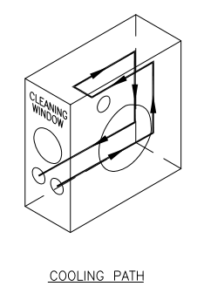Process Insights has introduced a temperature-controlled, multi-purpose flow cell (MPFC) for FT-NIR analyzers. The flow cell now comes with internal tubings for cooling or heating fluids. Although the heat exchanged is not enough to influence a quickly flowing sample, it helps maintain the temperature of a preconditioned sample.
Significance of Controlling the Temperature of the Sample Interface
In certain applications such as polymer cross-linking, high viscosity fluids, or nucleation reactions, the fluid temperature needs to be accurately controlled to make sure that the reaction continues as predicted and passes via the flow cell. If there is a reduction in temperature, the fluid may solidify in the flow cell, or the length of the polymer chain may not be accurate.

The above image shows the path of the heat exchange fluid. Image Credit: Process Insights.
When to Use a Flow Cell Instead of an Insertion Probe?
The range of MPFCs from Process Insights is used when the process material does not need further assurance of the High Safety Flow Cell, or whenever direct insertion probes are not suitable. One of the main benefits of close infrared process spectroscopy is the use of intrinsically safe fiber-optic cables to locate the probe remotely.
Although direct insertion probes avoid sample systems, sample loops, and the issues related to them, at times, it is essential to install sample loops for service, safety, and/or sample conditioning reasons.
The MPFC is a compact, robust, and user-friendly sample interface that can be installed easily and serviced even more easily. The sapphire windows of the MPFC can be cleaned by removing a clean-out plug to access the windows directly. This is done without disconnecting the fiber-optic cables or process lines. The clean-out port is a novel feature designed by Process Insights.
The Heated Flow Cell is Compatible with Bruker Matrix-F and ABB FT-NIR Spectrometers
Process Insights has manufactured the heated flow cell so that it can be fully integrated into all fiber-optic spectrophotometers. The heated flow cell can be used with AIT’s optical analyzers, ABB’s complete range of FT-NIR spectrometers, and the Matrix-F FT-NIR analyzer.
Process Insights’s sample interfaces offer market-leading optical efficiency that will enhance the optical performance of any spectrometer when linked with 400–600 µm fiber optical cables and FC or SMA 905 connectors. The Clearview DB photometer and the NIR-O Full Spectrum DG-NIR Spectrometer are the only analyzers designed to be “optically matched’’ with Process Insights’s probes.
Exceptional Light Transmission
The MPFC offers excellent optical performance just like other optical probes from Process Insights. Generally, peak transmission goes beyond 50%, which means more signal and lower measurement noise that collectively translate to lower limits of detection. Purchasing a Process Insights probe will enhance the performance of any spectrometer.
Operating Range
The MPFC works over the temperature and pressures ranges given below:
- A certified version rated to 1000 psi is available
- Temperatures of up to 300 °C (dependent on O-ring material)
- Pressure of up to 500 psi (dependent on O-ring durometer)
This flow cell comes in five standard pathlengths—1, 2, 5, 10, and 20 mm.
Process-Resistant Construction
While the MPFC comes in standard 316 L stainless steel, it is also available in several other alloys. Appropriate O-ring materials should be specified to fulfill the process chemistry and safety needs of users.
Typical materials like EPDM, Kalrez®, Viton, etc., are easily available. Users can check suitable resources for temperature specifications of different O-ring materials and chemical compatibility with their process.
A System with a Simple, Serviceable Design
The major elements of the MPFC design are the GW clean-out port, simple and serviceable O-ring seals, a clean flow pattern, sapphire windows, slip jointed conduit-ready connections, high optical efficiency, and O-ring-sealed optics to avoid ambient moisture infiltration.
The probe can be disassembled in the field for O-ring service and reassembled without altering the optical path length—an important parameter for repeatable measurements.
Dual Seal for Added Safety
Process Insights’s MPFCs now include a dual seal at the sapphire “window-to-process” interface. This provides more protection to the costly internal optical lens.
- Collimated beam for exceptional light transmission
- Threaded chamber ensures circulation of cooling or heating fluids
- Ideal for several installations, like sample conditioning systems, sample loops, or side streams
- Clean out port enables effortless window cleaning
- Can be used with all makes and models of spectrometers and photometers
- Can be used where a sample’s temperature needs to be controlled
How to Clean an NIR or UV-Vis Insertion Process Flow Cell Guided Wave